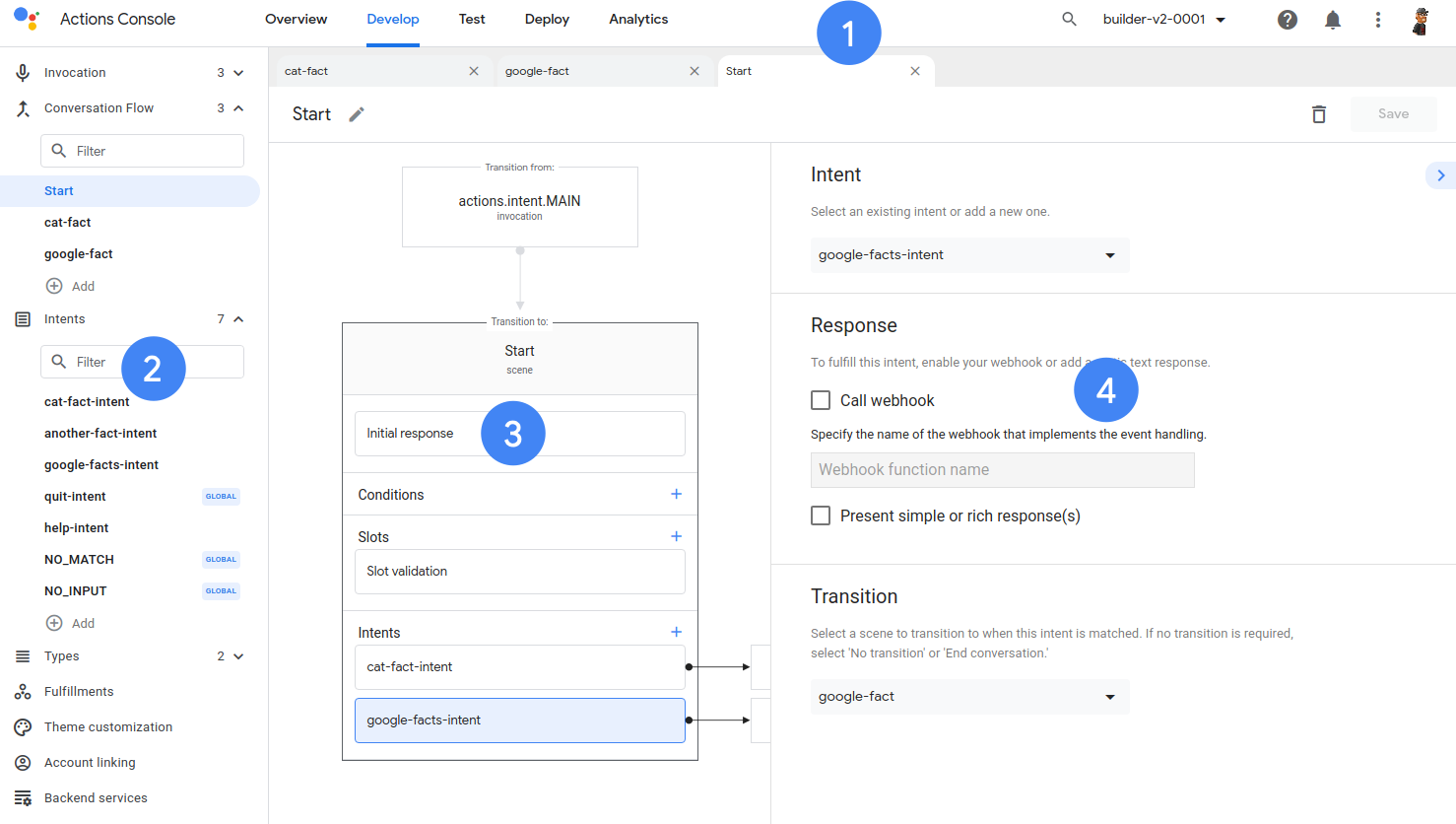لإنشاء "مهام قائمة على المحادثة"، عليك إنشاء المكوّنات التالية ونشرها:
- مشروع الإجراءات: هو الحاوية المنطقية لكل الإجراءات الحوارية وخدمات الويب وتطبيقات الويب. ويحدّد أيضًا إعدادات المشروع والموارد التي تشرح كيفية نشر مشروعك على "إجراءات Google".
- نموذج الاستدعاء: يحدّد هذا النموذج الطريقة التي يكتشف بها المستخدمون الإجراءات داخل مشروعك ويبدؤون بها. يمكنك إنشاء نموذج الاستدعاء باستخدام النوايا والأنواع.
- نموذج المحادثة: يحدّد ما يمكن للمستخدمين قوله لـ "الإجراءات" وكيفية استجابة "الإجراءات" للمستخدمين. يمكنك إنشاء نموذج المحادثة باستخدام النوايا والأنواع والمشاهد والطلبات.
- خطافات الويب: يمكن أن تؤدي الإجراءات إلى تشغيل خطافات الويب لتفويض منطق إضافي إلى خدمات التنفيذ، مثل إنشاء الطلبات والتحقّق من صحة البيانات وغير ذلك.
- Interactive Canvas: بدلاً من إرسال ردود نصية بسيطة أو بطاقات وصور تفاعلية، يمكنك تقديم تطبيق ويب تفاعلي بملء الشاشة يستند إلى HTML وCSS وJavaScript.
توضّح الأقسام التالية الأدوات التي ستستخدمها لإنشاء الإجراءات.
المهام
واجهة برمجة التطبيقات Actions API هي مجموعة من أدوات المطوّرين لإنشاء "مهام" لـ "مساعد Google". وتتكوّن من الميزات التالية:
تمثيل مفتوح يستند إلى الملفات لمشروع "الإجراءات على Google": يمكنك إنشاء نماذج طلبات التفعيل والمحادثات باستخدام النوايا والأنواع والمشاهد والطلبات. يمكنك تعديل مشاريع "الإجراءات" باستخدام محرّر النصوص المفضّل لديك، وإضافتها إلى نظام التحكّم بالمصادر، وإنشاء عمليات مبرمَجة، وغير ذلك.
واجهة سطر الأوامر (CLI): توفّر أداة
gactionsواجهة سطر الأوامر لتسريع عملية إعداد التطبيقات وتنفيذها آليًا. يتيح لك ذلك تهيئة ملفات مشاريع Action العادية، وإرسال التحديثات إلى Actions Console، ونشر مشاريع Action، وغير ذلك. تتيح لك الأداة تنفيذ العديد من مهام سير العمل الشائعة، مثل استيراد المشاريع الحالية أو بدء العمل على فرع ميزة باستخدام نظام التحكّم بالمصادر المفضّل لديك.واجهة Actions API: هي واجهة برمجة التطبيقات نفسها التي تستخدمها أداة
gactions. توفّر Actions API قائمة بنقاط نهاية REST لإدارة "الإجراءات"، بما في ذلك الاختبار والإنشاء. تتيح لك واجهة برمجة التطبيقات استخدام طلبات JSON لتنفيذ العديد من مهام سير العمل الشائعة. عند استخدام Actions API، هناك بعض الحدود وأفضل الممارسات التي يجب مراعاتها.خطافات الويب ومكتبة تنفيذ Node.js: يمكن أن تفوّض "إجراءاتك" منطق النشاط التجاري إلى خدمات الويب باستخدام خطافات الويب وتنسيق مراسلة مستند إلى JSON. نوفّر مكتبة تنفيذ Node.js توفّر واجهات اصطلاحية لبرنامج Conversation Webhook. تسهّل هذه المكتبة تنفيذ العديد من مسارات المستخدمين الشائعة. على سبيل المثال، تتضمّن بعض الميزات استخراج المَعلمات من طلب بحث يقدّمه المستخدم وإنشاء تجربة متعددة الوسائط (صوت فقط وصوت ومرئيات) لـ "مساعد Google".
Actions Builder
توفّر لك أداة Actions Builder بيئة تطوير متكاملة (IDE) فعّالة وسهلة الاستخدام ومستندة إلى الويب، وهي مدمجة في Actions Console. بما أنّ Actions Builder تستند إلى التكنولوجيات نفسها التي تستخدمها Actions API، يمكنك استخدامها بمفردها أو مع Actions API حسب احتياجاتك.

تنقسم واجهة مستخدم "أداة إنشاء الإجراءات" إلى الأقسام التالية:
- تتيح القائمة العلوية الوصول إلى الأقسام المختلفة في Actions Console، ويمكنك الوصول إلى Actions Builder من خلال علامة التبويب تطوير.
- تتيح لك القائمة اليمنى الوصول إلى جميع المكوّنات اللازمة لإنشاء الإجراءات، مثل النوايا والمَشاهد.
- تتيح لك منطقة الإنشاء إنشاء المكوّن الذي تعمل عليه.
- تتيح لك منطقة التفاصيل ضبط المزيد من التفاصيل حول المكوّن الذي تعمل عليه.

